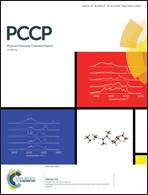A DFT assessment of some physical properties of iodine-centered halogen bonding and other non-covalent interactions in some experimentally reported crystal geometries
Abstract
A set of six binary complexes that feature iodine-centered halogen bonding, extracted from structures deposited in the Cambridge Structure Database, has been examined computationally using density functional theory calculations with the M06-2X global hybrid, and dispersion corrected B3LYP-D3 and B97-D3, to determine their equilibrium geometries, binding energies and electronic properties. The results show that gas phase calculations are very informative in evaluating what occurs in the solid state, even though these calculations ignore the importance of lattice packing and counter ion effects. The calculated binding energies for the non-covalent interactions responsible for these complexes lie between −4.15 and −7.48 kcal mol−1 (M06-2X), which enables us to characterize them as weak-to-moderate in strength. The basis set superposition error energies are calculated to vary between 0.60 and 2.42 kcal mol−1 for all the complexes examined, even though an all-electron QZP basis set used in the analysis was of quadrupole-ζ (plus polarization) quality. Dispersion is found to have a profound effect on the binding energy of some of these complexes, and was estimated to be as large as 5.0 kcal mol−1. For one complex, the crystal geometry could not be precisely reproduced using a gas phase calculation. While both halogen- and hydrogen-bonding interactions were found competitive, they cooperate with each other to determine the stable configuration of the binary complex. The molecular electrostatic surface potential, quantum theory of atoms in molecules, and reduced density gradient non-covalent Interaction models were utilized to arrive at a fundamental understanding of the various inter- and intra-molecular molecular interactions involved, as well as some other previously-overlooked non-covalent interactions that emerge in the modelling.



 Please wait while we load your content...
Please wait while we load your content...